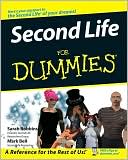Coming of Age in Second Life: An Anthropologist Explores the Virtually Human
[Richard A. Bartle, Author of Designing Virtual Worlds] Tom Boellstorff describes Second Life warmly and intelligently, highlighting its issues in a thought-provoking manner that is always backed up with evidence. There's an almost tangible depth to his analysis that makes it really stand out. This is just the kind of portrait of a virtual world that I've been waiting to see for years: a full-blooded, book-length tour de force.\ [Douglas Thomas, Author of Hacker Culture] This is the first...
Search in google:
"Tom Boellstorff describes Second Life warmly and intelligently, highlighting its issues in a thought-provoking manner that is always backed up with evidence. There's an almost tangible depth to his analysis that makes it really stand out. This is just the kind of portrait of a virtual world that I've been waiting to see for years: a full-blooded, book-length tour de force."--Richard A. Bartle, author of Designing Virtual Worlds"This is the first book to take a sustained look at an environment like Second Life from a purely anthropological perspective. It is sure to become the basis for a new conversation about how we study these spaces. It is impossible to read this book and not come away asking questions about how our lives are being transformed in very real ways by what is happening in the virtual."--Douglas Thomas, author of Hacker Culture"Taking the bold step of conducting ethnographic fieldwork entirely 'inside' Second Life, Tom Boellstorff invites readers to meditate on the old and new meanings of the virtual and the human. He presses the inventive and compelling claim that anthropologists would do well to imagine culture itself as already harboring the notion of the virtual. Boellstorff argues that being 'virtually human' is what we have been all along."--Stefan Helmreich, author of Silicon Second Nature Art Review Boellstorff's anthropologist's insight into advanced societies helps us to see them anew.
Coming of Age in Second Life An Anthropologist Explores the Virtually Human \ \ By Tom Boellstorff Princeton University Press \ Copyright © 2008 Princeton University Press\ All right reserved.\ ISBN: 978-0-691-13528-1 \ \ \ \ Chapter One The Subject and Scope of This Inquiry \ Arrivals and departures-Everyday Second Life-Terms of discussion-The emergence of virtual worlds-The posthuman and the human-What this, a book, does.\ Arrivals and Departures.\ Imagine yourself suddenly set down surrounded by all your gear, alone on a tropical beach close to a native village while the launch or dinghy which has brought you sails away out of sight (figure 1.1). You have nothing to do, but to start at once on your ethnographic work. Imagine further that you are a beginner, without previous experience, with nothing to guide you and no one to help you. This exactly describes my first initiation into field work in Second Life.\ Many anthropologists will recognize the paragraph above as a famous passage, slightly altered, from Bronislaw Malinowski's Argonauts of the Western Pacific, published in 1922, describing the culture of the inhabitants of the Trobriand Islands north of Australia. Despite his shortcomings, it was Malinowski more than any other anthropologist, and Argonauts more than any of Malinowski's books, that established the conviction that anthropologists should have extended experience in close proximity among those about whose lives they wished to speak:"it would be easy to quote works of high repute ... in which wholesale generalizations are laid down before us, and we are not informed at all by what actual experiences the writers have reached their conclusion" (Malinowski 1922:3, emphasis added): "Living in the village with no other business but to follow native life, one sees the customs, ceremonies and transactions over and over again, one has examples of their beliefs as they are actually lived through, and the full body and blood of actual native life fills out soon the skeleton of abstract constructions" (Malinowski 1922:18, emphasis added). Malinowski speaks of "actual" experience, "actual" belief, "actual" life. In this book I take the methods and theories of anthropology and apply them to a virtual world accessible only through a computer screen. Because virtual worlds are so new, I will spend quite a few pages introducing some general issues to keep in mind, before plunging into the details of Second Life. I am an anthropologist whose previous and continuing research focuses on sexuality in Indonesia (Boellstorff 2005, 2007). Coming of Age in Second Life is an anthropological study of Second Life (abbreviated "SL" or "sl"). This is a virtual world owned and managed by a company, Linden Lab, where by the end of my fieldwork tens of thousands of persons who might live on separate continents spent part of their lives online. To explore how anthropology might contribute to understanding culture in virtual worlds, I have departed from many previous studies of Internet culture by conducting fieldwork entirely inside Second Life, using my avatar Tom Bukowski and my home and office in Second Life, Ethnographia. I went through standard human subjects protocols and engaged in normal anthropological methods including participant observation and interviews.\ It might seem controversial to claim one can conduct research entirely inside a virtual world, since persons in them spend most of their time in the actual world and because virtual worlds reference and respond to the actual world in many ways. However, as I discuss in chapter 3, studying virtual worlds "in their own terms" is not only feasible but crucial to developing research methods that keep up with the realities of technological change. Most virtual worlds now have tens of thousands of participants, if not more, and the vast majority interact only in the virtual world. The forms of social action and meaning-making that take place do so within the virtual world, and there is a dire need for methods and theories that take this into account.\ Another foundational conceit concerns the possibility of descriptive analysis, rather than the prescriptive modes of argumentation that characterize most discussions of virtual worlds, often due to legitimate interests in social implications and design. When studying gay Indonesians, I do not ask "is it a good thing that gay identities have emerged in Indonesia?"; I take their emergence as given. Similarly in this book I do not ask "is it a good thing that virtual worlds have emerged" or "is Second Life headed in the right direction?" While such questions are important to many persons in Second Life and beyond, in this book I take Second Life's emergence as given and work to analyze the cultural practices and beliefs taking form within it.\ The idea of "virtually human" appearing in this book's subtitle can be interpreted in two ways, indexing two lines of analysis I develop throughout. First, although some insightful research has claimed that online culture heralds the arrival of the "posthuman," I show that Second Life culture is profoundly human. It is not only that virtual worlds borrow assumptions from real life; virtual worlds show us how, under our very noses, our "real" lives have been "virtual" all along. It is in being virtual that we are human: since it is human "nature" to experience life through the prism of culture, human being has always been virtual being. Cutlure is our "killer app": we are virtually human.\ Yet it is not true that nothing is new under the unblinking light of a virtual sun. My second line of analysis is that virtual worlds do have significant consequences for social life. Drawing upon the meaning of virtual as "almost," a second interpretation of this book's title is that in virtual worlds we are not quite human-our humanity is thrown off balance, considered anew, and reconfigured through transformed possibilities for place-making, subjectivity, and community. Anthropology, "a positive and definite study of the human knowledge of the human" (Wagner 2001:xvii), can help reveal the layers of contingency within the category of the virtually human, rather than exiling such contingency into a category of the posthuman and thereby retrenching the borders of the human itself. I approach these two lines of analysis by writing an "ethnography," a text produced through fieldwork-based research, also known as ethnographic methods. Contemporary understandings of ethnographic method presume historical and comparative perspectives, and at various points I will discuss the history of virtual worlds as well as virtual worlds other than Second Life.\ The online fieldsite of Coming of Age in Second Life might seem utterly different than Indonesia, but like my earlier work this book touches on broad issues concerning selfhood and society, and like my earlier work this book is a methodological experiment. Building upon a significant body of prior research on virtual worlds, I argue that ethnography holds great promise for illuminating culture online, but not because it is traditional or old-fashioned. Ethnography has a special role to play in studying virtual worlds because it has anticipated them. Virtual before the Internet existed, ethnography has always produced a kind of virtual knowledge. Borrowing a phrase from Malinowski, Clifford Geertz argued that the goal of ethnographic understanding is to achieve the "native's point of view" (Geertz 1983). The quotation from Malinowski that started this book asked you to "imagine yourself" in a new place (Malinowski 1922:4), to be virtually there. Representations of persons in virtual worlds are known as "avatars"; Malinowski's injunction to "imagine yourself" in an unfamiliar place underscores how anthropology has always been about avatarizing the self, standing virtually in the shoes (or on the shores) of another culture.\ I intentionally draw upon classic anthropology to demonstrate the promise of ethnographic methods for the study of virtual worlds. This book's title is meant to recall Coming of Age in Samoa, the work that first established Margaret Mead's reputation (Mead 1928). At the same time, it will be obvious that I draw upon contemporary anthropological critiques of ethnographic method-not least, the vociferous debate over Mead's book. Anthropologists now recognize that the boundaries of "fieldsites" are contested and produced in part by ethnographers themselves (Gupta and Ferguson 1997). They also recognize that ethnographic research need not limit itself to a single fieldsite. Indeed there is a sense in which this study of Second Life is part of my own multisited project, an anthropology of modernity that treats gay Indonesians and Second Life residents as nodes of an emergent cultural formation that is at once transnational, national, and local, at once virtual and actual.\ Many different kinds of books could be written about Second Life, each with certain audiences in mind. A challenge I face is that I wish Coming of Age in Second Life to be read and debated by several different groups of people. I hope the book will be useful to those with interests in anthropology, including graduate and undergraduate students. I also hope it will be read by scholars, students, and designers in fields like game studies, informatics, and science and technology studies. Another hoped-for readership includes persons who participate in virtual worlds or online games. Persons who spend time in Second Life fall into this category, including the many friends and acquaintances whose kindness, patience, and insight made this book possible. Then there are all the readers I cannot foresee who simply find the topic interesting.\ It is impossible to write a book that will please all of these audiences all of the time. Some may find my writing too laden with jargon; others, too informal. Some may find my extensive use of sources distracting; others may think of literatures they would have liked to see referenced. Some may be frustrated with my sympathetic stance toward virtual worlds; others will feel I underplay their importance. Those with little experience in virtual worlds may wish I had focused on why people find virtual worlds compelling, and their potentially negative effects; others with substantial experience in virtual worlds may wish I had written a book that went into more detail about subcultures and controversies specific to Second Life. I can only hope that all parties will meet this text halfway and find in it something useful or provocative.\ This book provides an ethnographic portrait of the culture of Second Life during the period of fieldwork upon which the portrait is based (June 3, 2004 to January 30, 2007). Since Second Life first went online in June 2003, this book chronicles the formative years when the virtual world was "coming of age," as the book's title indicates. A problem of spatial scale appears at the outset: "Second Life" seems too big and too small. Too small, because most of those who resided in Second Life during my fieldwork participated in other virtual worlds or online games, as well as blogs, forums, and other websites. The engagement ethnographic research demands makes it impossible for me to conduct ethnographic research in Thailand while conducting such research in Indonesia; similarly I could not study other virtual worlds while engaging in ethnographic research in Second Life. For this reason, comparing Second Life to other virtual worlds in detail lies beyond the scope of this book. Without good ethnographic work in place there is nothing upon which to base comparison. Obviously all virtual worlds differ and Second Life was quite distinct from, say, combat-oriented virtual worlds that existed at the same time, like World of Warcraft (Koster 2006). Yet there are common aspects to virtual worlds, just as there are features shared by all human languages even when they are mutually unintelligible.\ Too big, because as was the case for many virtual worlds during the time of my fieldwork, Second Life was already so large that there were many subcultures within it. At various points I discuss subcultures in Second Life and in future writings I hope to analyze such subcultures in greater detail, but the goal of this book is to explore what might be learned from Second Life taken as a single culture. Just as it is possible to study Indonesian national culture or more localized cultures like Javanese culture, so one viable approach to Second Life is to examine its general aspects. It is typically much easier to recognize subcultures than cultures: no one during my research denied that there were subcultures in Second Life, but many questioned if there was a Second Life culture. Claims that a virtual world like Second Life is composed of nothing but subcultures mistake notions of subculture in terms of identity and style (Hebdige 1979) for anthropological notions of culture in terms of shared meanings and relations of power.\ Everyday Second Life.\ A man spends his days as a tiny chipmunk, elf, or voluptuous woman. Another lives as a child and two other persons agree to be his virtual parents. Two "real"-life sisters living hundreds of miles apart meet every day to play games together or shop for new shoes for their avatars. The person making the shoes has quit his "real"-life job because he is making over five thousand\ U.S. dollars a month from the sale of virtual clothing. A group of Christians pray together at a church; nearby another group of persons engages in a virtual orgy, complete with ejaculating genitalia. Not far away a newsstand provides copies of a virtual newspaper with ten reporters on staff; it includes advertisements for a "real"-world car company, a virtual university offering classes, a fishing tournament, and a spaceflight museum with replicas of rockets and satellites.\ This list of occurrences does not begin to scratch the surface of the myriad ways those who spent time in Second Life interacted with each other and the virtual world. During the time of my fieldwork, the level of "real" world news coverage of Second Life increased dramatically, often focusing on aspects of the virtual world seen as sensational (for instance, that over US$1,000,000 of economic activity was occurring daily, or that a "real" world musician was performing inworld). But events seen as exceptional are of limited value; they take place in the context of broader norms that at first glance may seem uninteresting, but are the true key to understanding culture. For this reason it will prove helpful to introduce Second Life not by means of some infamous incident, but through a portrait of what an uneventful afternoon might have looked like during the time of my fieldwork. I do not intend this portrait to be representative of everyone's experience, just one example of what life in Second Life could be like during my fieldwork. Readers with experience in virtual worlds may find the description obvious, but I would ask such readers to consider what kinds of cultural assumptions are encapsulated within these apparently banal details of everyday Second Life.\ IMAGINE YOURSELF suddenly teleported into Second Life, alone in your home. You already have a Second Life account and thus an "avatar," which we will call Sammy Jones. On a computer-at home, at an office, or on your laptop at a café-you start the Second Life program just as you would an email program, word processor, or web browser. After logging on with your avatar name and password, you see your avatar, who never needs to eat or sleep, standing in your home (figure 1.2). You built this house out of "primitives" (or "prims"), as objects in Second Life are known. You did so after practicing with Second Life's building tools in an area known as a "sandbox," where you can build for free but everything you build is deleted after a few hours (figure 1.3). The piece of land upon which your house sits is 1,024 square virtual meters in size; you paid a virtual real estate agent about thirty dollars for it, conducting the transaction in linden dollars or "lindens." For the right to own land you paid Linden Lab, the company that owns Second Life, $9.95 a month for a "premium account" and an additional $5 a month for the ability to own up to 1,024 square meters of land: this is known as a "land use fee" or "tier fee."\ (Continues...)\ \ \ \ \ Excerpted from Coming of Age in Second Life by Tom Boellstorff\ Copyright © 2008 by Princeton University Press. Excerpted by permission.\ All rights reserved. No part of this excerpt may be reproduced or reprinted without permission in writing from the publisher.\ Excerpts are provided by Dial-A-Book Inc. solely for the personal use of visitors to this web site. \ \
List of IllustrationsPt. I Setting the Virtual Stage 1Ch. 1 The Subject and Scope of This Inquiry 3Ch. 2 History 32Ch. 3 Method 60Pt. II Culture in a Virtual World 87Ch. 4 Place and Time 89Ch. 5 Personhood 118Ch. 6 Intimacy 151Ch. 7 Community 179Pt. III The Age of Techne 203Ch. 8 Political Economy 205Ch. 9 The Virtual 237Glossary 251Notes 255Works Cited 271Index 303
\ Nature\ - David Robson\ The gap between the virtual and the physical, and its effect on the ideas of personhood and relationships, is the most interesting aspect of Boellstorff's analysis. . . . Boellstorff's portrayal of a virtual culture at the advent of its acceptance into mainstream life gives it lasting importance, and his methods will be a touchstone for research in the emerging field of virtual anthropology.\ \ \ \ \ Scientific American\ - Michelle Press\ Boellstorff applies the methods and theories of his field to a virtual world accessible only through a computer screen....[He] spent two years participating in Second Life and reports back as the trained observer that he is. We read about a fascinating, and to many of us mystifying, world. How do people make actual money in this virtual society? (They do.) How do they make friends with other avatars? The reader unfamiliar with such sites learns a lot—not least, all sorts of cool jargon...Worth the hurdles its scholarly bent imposes.\ \ \ Guardian\ - Steven Poole\ Boellstorff's book is full of fascinating vignettes recounting the blossomings of friendships and romances in the virtual world, and musing fruitfully on questions of creative identity and novel problems of etiquette.\ \ \ \ \ Times Higher Education\ - Grant McCracken\ Where many of his colleagues insist on making a mystery of things that are straightforward (so to neglect mysteries real and pressing), Boellstorff is a likeable, generous, accessible voice. . . . This book, once it gets down to it, does truly offer a detailed and deeply interesting investigation of Second Life.\ \ \ \ \ Choice\ - A. Arno\ Boellstorff makes important contributions to ethnographic theory and method while providing a fascinating excursion into a virtual world, Second Life, inhabited by graphic manifestations of real-life people who interact with one another in localized parts of a vast virtual landscape that they themselves have largely created. . . . In classic anthropological fashion, Boellstorff entered Second Life, conducted ethnographic research within it as an avatar, and has written a vivid, highly engaging account of that world for real-life readers.\ \ \ \ \ Centre Daily Times\ - Peter Crabb\ While it is geared toward anthropologists, the book will be of interest to a wide general audience, with the caveat that it may be helpful to keep a dictionary handy to decode some jargon. . . . [Tom Boellstorff] provides us with a solid foundation for important discussions about he value of technology in our everyday lives.\ \ \ \ \ Metapsychology\ - Rob Harle\ This is a remarkable book. Tom Boellstorff has successfully achieved the extremely difficult task of writing a book that will appeal equally to the general reader and scholar alike. Coming Of Age In Second Life is well written, very well researched and whilst it does not get bogged down in academic detail and theory, it does provide reference to such theories that undergird the author's research.\ \ \ \ \ European Legacy\ - Marilyn Strathern\ One can almost guarantee this book will become one of those contemporary classics in anthropology that travel beyond the discipline as well.\ \ \ \ \ Current Anthropology\ - Christopher M. Kelty\ The book is absolutely invaluable for anyone who wants to understand what's happening with virtual worlds. Like the very best of ethnography, it transports; it is classically thick with descriptions of everything from the linguistic and the proxemic to the metaphysical and the erotic.\ \ \ \ \ Social Anthropology\ - Paula Uimonen\ The monograph is an elegant tribute to the relevance and strengths of anthropology in the study of virtual worlds, a field of growing social significance that younger generations in particular are keen to investigate more fully. This was evident when I introduced the book to students in a recent course on digital anthropology, who could relate it to their own online every day experiences. As one of the early Internet ethnographers, I can but appreciate Boellstorff's efforts in strengthening this important domain of research, while crafting analytical tools with which to better understand the virtual essence of the human condition, as exposed to us through Internet-mediated virtual worlds.\ \ \ \ \ NatureThe gap between the virtual and the physical, and its effect on the ideas of personhood and relationships, is the most interesting aspect of Boellstorff's analysis. . . . Boellstorff's portrayal of a virtual culture at the advent of its acceptance into mainstream life gives it lasting importance, and his methods will be a touchstone for research in the emerging field of virtual anthropology.\ — David Robson\ \ \ \ \ Scientific AmericanBoellstorff applies the methods and theories of his field to a virtual world accessible only through a computer screen....[He] spent two years participating in Second Life and reports back as the trained observer that he is. We read about a fascinating, and to many of us mystifying, world. How do people make actual money in this virtual society? (They do.) How do they make friends with other avatars? The reader unfamiliar with such sites learns a lot—not least, all sorts of cool jargon...Worth the hurdles its scholarly bent imposes.\ — Michelle Press\ \ \ \ \ GuardianBoellstorff's book is full of fascinating vignettes recounting the blossomings of friendships and romances in the virtual world, and musing fruitfully on questions of creative identity and novel problems of etiquette.\ — Steven Poole\ \ \ \ \ New ScientistIf you thought a virtual world like Second Life was a smorgasbord of experimental gender swaps, nerd types engaging in kinky sex or entrepreneurs cashing in on real world money making possibilities, think again. . . .Could Boellstorff be right that we're all virtual humans anyway, viewing the world as we do through the prism of culture?\ \ \ \ \ Art ReviewBoellstorff's anthropologist's insight into advanced societies helps us to see them anew.\ \ \ \ \ Times Higher EducationWhere many of his colleagues insist on making a mystery of things that are straightforward (so to neglect mysteries real and pressing), Boellstorff is a likeable, generous, accessible voice. . . . This book, once it gets down to it, does truly offer a detailed and deeply interesting investigation of Second Life.\ — Grant McCracken\ \ \ \ \ ChoiceBoellstorff makes important contributions to ethnographic theory and method while providing a fascinating excursion into a virtual world, Second Life, inhabited by graphic manifestations of real-life people who interact with one another in localized parts of a vast virtual landscape that they themselves have largely created. . . . In classic anthropological fashion, Boellstorff entered Second Life, conducted ethnographic research within it as an avatar, and has written a vivid, highly engaging account of that world for real-life readers.\ — A. Arno\ \ \ \ \ Centre Daily TimesWhile it is geared toward anthropologists, the book will be of interest to a wide general audience, with the caveat that it may be helpful to keep a dictionary handy to decode some jargon. . . . [Tom Boellstorff] provides us with a solid foundation for important discussions about he value of technology in our everyday lives.\ — Peter Crabb\ \ \ \ \ MetapsychologyThis is a remarkable book. Tom Boellstorff has successfully achieved the extremely difficult task of writing a book that will appeal equally to the general reader and scholar alike. Coming Of Age In Second Life is well written, very well researched and whilst it does not get bogged down in academic detail and theory, it does provide reference to such theories that undergird the author's research.\ — Rob Harle\ \ \ \ \ European LegacyOne can almost guarantee this book will become one of those contemporary classics in anthropology that travel beyond the discipline as well.\ — Marilyn Strathern\ \ \ \ \ Current AnthropologyThe book is absolutely invaluable for anyone who wants to understand what's happening with virtual worlds. Like the very best of ethnography, it transports; it is classically thick with descriptions of everything from the linguistic and the proxemic to the metaphysical and the erotic.\ — Christopher M. Kelty\ \ \ \ \ Social AnthropologyThe monograph is an elegant tribute to the relevance and strengths of anthropology in the study of virtual worlds, a field of growing social significance that younger generations in particular are keen to investigate more fully. This was evident when I introduced the book to students in a recent course on digital anthropology, who could relate it to their own online every day experiences. As one of the early Internet ethnographers, I can but appreciate Boellstorff's efforts in strengthening this important domain of research, while crafting analytical tools with which to better understand the virtual essence of the human condition, as exposed to us through Internet-mediated virtual worlds.\ — Paula Uimonen\ \








